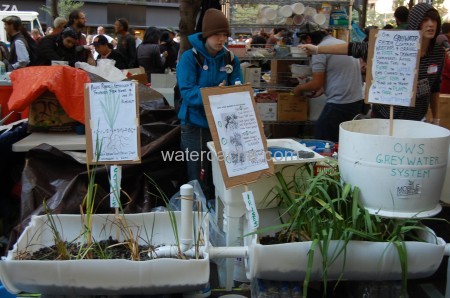Whether you like it or not, Occupy Wall Street is changing our democracy. This blog post is not about the politics behind the demonstrations in New York City’s Zuccotti Park, but it is about something that is normally “behind the scenes”… graywater.
The Uniform Plumbing Code (UPC) defines graywater as:
Untreated household waste water that has not come into contact with toilet waste. Gray water includes used water from bathtubs, showers, and bathroom wash basins, and water from clotheswashers and laundry tubs. It shall not include wastewater from kitchen sinks or dishwashers.
The International Plumbing Code (IPC) definition is a little more vague:
Waste discharged from lavatories, bathtubs, showers, clothes washers, and laundry trays.
So apparently, with the live-in demonstration, the protesters have dishes to wash. They are basically washing them like you would while camping out, with tubs of wash water and rinse water. Technically, you wouldn’t be able to use dishwashing water in a graywater system (see definitions above) but the Mobile Design Lab saw a great opportunity. They wanted to create a graywater reuse system that not only helped dispose of the graywater but also educated people about graywater reuse systems. From their website, the Mobile Design Lab “creates and facilitates events that engage and empower people to design and build the world they want to live in.” Most of their concepts are centered around permaculture.
Basically, they pour the dirty dish water into an initial biofilter basin that contains wood chips. The wood chips are used because they provide plenty of surface area so that bacteria can set up and degrade the organic nutrients (fats and soaps) in the dish water. Once the water filters through the biofilter, it comes out the bottom of the basin and flows into another basin which is planted with water-loving plants. It flows through this basin in a subsurface pipe which distributes the graywater into the soil strata. They have it set up to flow into another basin. Since this type of graywater system is reliant on flow rate, all of the graywater doesn’t get treated or used. For the amount of dish water that is present, they would need a larger biofilter and more plant basins in order to process all of the graywater sufficiently.
Now, there are some pros and cons about this type of graywater system. The biggest advantage of this system is the simplicity. You don’t have any mechanical parts or parts that need power or electricity (if you don’t count physically carrying heavy tubs of dish water to pour it into the biofilter). The biggest disadvantage is the maintenance of the system. Once the wood chips in the biofilter have become inundated and unable to process the graywater, you will have to remove them and replace with new wood chips. You will be able to compost the wood chips then but you can probably imagine the state (and smell) of the soggy wood chips as you pull them out of the biofilter. This is not a big deal but you can probably think of people who wouldn’t want to do. Once it is not maintained, the system fails.
I have provided my description of their graywater system to help you understand it a little better, but I have located a few resources from the designers of the system. You can listen to a Now or Never Radio interview of Lisa Depiano, the designer of the graywater system. You can also check out this video that shows how they set up their “on-the-spot” graywater system.
Photo credit: Makeba Seargeant




